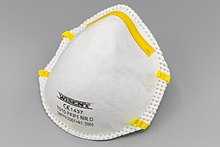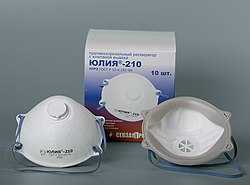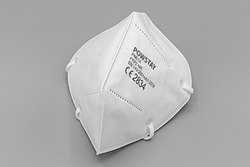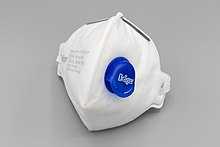FFP standards EN149
EN 149 is a Europe standard of testing and marking requirements for filtering half masks.
Such masks cover the nose, mouth and chin and may have inhalation and/or exhalation valves. EN 149 defines three classes of such particle half masks, called FFP1, FFP2 and FFP3, (FFP = filtering facepiece) according to their filtering efficiency. It also classifies masks into "single shift use only" (not re-useable, marked NR) or "re-usable (more than one shift)" (marked R), and an additional marking letter D indicates that a mask has passed an optional clogging test using dolomite dust. Such mechanical filter respirators protect against the inhalation of particle such as dust particles, droplets, and aerosols.
Almost identical tests (but different markings) are used in Australia, New Zealand, Korea and Brazil. Similar standards are used in the United States, China and Japan. For example, EN 149 FFP2 masks have similar performance requirements to N95 masks in the United States and KN95 filters of China, and EN 149 FFP3 masks have similar performance requirements to N99 masks in the United States. However EN 149 test requirements differ somewhat from the U.S./Chinese/Japanese standards: EN 149 requires an additional paraffin-oil aerosol test and it tests at a range of different flow rates and defines several associated and permissible pressure drop levels.
The EN 149 standard defines performance requirements for three classes of particle-filtering half masks: FFP1, FFP2 and FFP3. The protection provided by an FFP2 (or FFP3) mask includes the protection provided by a mask of the lower-numbered classes.
A mask conforming to the standard must have its class written on it, along with the name of the standard and its year of publication, as well as any applicable option codes, e.g. “EN 149:2001 FFP1 NR D”. Some manufacturers use in addition the colour of the elastic band to identify the mask class, however, the EN 149 standard does not specify any such colour coding and different manufacturers have used different colour schemes.
| Class | Filter penetration limit (at 95 L/min air flow) | Inward leakage | Typical elastic band |
|---|---|---|---|
| FFP1 | Filters at least 80% of airborne particles | <22% | Yellow |
| FFP2 | Filters at least 94% of airborne particles | <8% | Blue or White |
| FFP3 | Filters at least 99% of airborne particles | <2% |
Red |
FFP1 mask
It is the least filtering mask of the three.
- Aerosol filtration percentage: 80% minimum.
- Internal leak rate: maximum 22%.
It is mainly used as a dust mask (for example for DIY jobs). Dust can cause lung diseases, such as silicosis, anthracosis, siderosis and asbestosis (in particular dust from silica, coal, iron, ore,zinc, aluminium or even cement).
FFP2 mask
- Aerosol filtration percentage: Not less than 94%.
- Internal leak rate: maximum 8%.
FFP3 mask
- Aerosol filtration percentage: Not less than 99%.
- Internal leak rate: maximum 2%
The FFP3 mask is the most filtering of the FFP masks. It protects against very fine particles such as asbestos and ceramic. It does not protect against gases and in particular nitrogen oxide.
EN 149 tests the ability of masks to protect the wearers against inhaling liquid and dry aerosols. It makes no statement about, and does not specifically test the suitability of such masks for, Nevertheless, FFP2 and FFP3 masks are commonly used for this purpose in medical practice.
Several regions use standards based on nearly identical tests and thresholds as those in EN 149, but with different markings:
- Russia (GOST R 12.4.191-2011): identical.
- South Korea (KMOEL - 2017-64): considered identical to pre-2009 version. FFP1 is called "2nd grade" or KF80, FFP2 "1st grade" or KF94, and FFP3 "special grade" or KF99.
- Australia and New Zealand (AS/NZ 1716:2012): similar grades with a different test agent. Grades are written simply "P".
- Brazil (ABNT/NBR 13698:2011): identical to pre-2009 version. Grades are written as "PFF".
Other regions use similar tests that (in parts) resemble more closely the 42 CFR 84 requirements in the United States:
- Japan (JMHLW-Notification 214, 2018): similar grades with a different coding scheme for NR/R and S/L types. Written with a two-letter prefix D/R and S/L that maps to NR/R and S/L respectively. Leakage requirement not present.
- Taiwan (CNS 14755): D1/D2/D3 grades for 80/95/99 efficiency. No requirements for inward leakage.
- More information please visit : https://www.youtube.com/watch?v=FC6WswgBHkI&t=43s
2021-03-16 22:12
- Related News
What's the difference between a hydraulic oil filter and a regular oil filter?
Interpretation of Paper Tear Strength Standards
What is the significance of the LA abrasion test?
What is a UTM machine used for?
What is the principle of a capillary rheometer?
What is the difference between conical and parallel twin-screw extruders?
What is the ISO standard for color fastness?
What is the use of a roundness tester?
The Role of Dust-Proof Robot Protective Clothing
What is the difference between Taber and Martindale abrasion tests?




